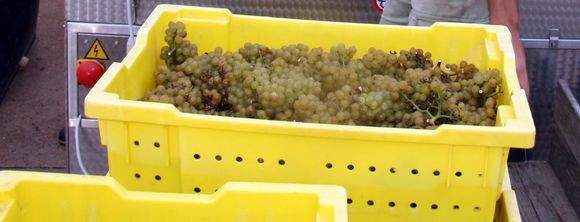
Story and photo by Jim Silver, General Manager, Peconic Bay Winery
I have been around the wine business long enough
(22 years)
to have seen many wine trends and fashions played out in the public
arena:
Australia's incredible rise and stunning fall; Germany's reawakening;
France’s fall from grace; pinot grigio’s leap from obscurity to
most popular import from Europe; California wines at 12.5% and now at
15.5%
alcohol.
There are others of course, but today's topic is that curious
love-hate relationship some of us have with chardonnay.
When I was a young tenderfoot in the wine business, I was fascinated by
the
obscure. New wine enthusiasts often are: They love the
“undiscovered” grape varieties, and the tiny producers in tiny
villages off the beaten track that produce tiny quantities of wine
you've never
heard of. These discoveries were always undervalued and marvelous. There
is no
denying how entertaining this sort of discovery is, especially if you
remember
that it wasn’t too long ago that viognier, albariño, grüner veltliner, malbec and carmenere were all but unknown outside of their hometowns.
And then there’s chardonnay.
Oh! The noble chardonnay! A duchess from
Burgundy, champion white wine of the West, and the true darling of the
1980s and 1990s. Yet chardonnay seem so “five minutes
ago,” like an Oldsmobile or Polaroid camera. Certainly the golden sweet, oaky,
ultra-richness of many chardonnays seems out of date to us today. A
somewhat
sudden change in our desire for this style of wine seems to have had
unintended
consequences for the unfortunate grape that made all of these Reagan-era
“oak bombs.”
Chardonnay, along with its tenderer sister riesling, is the best white
wine
grape in the world to survive, thrive, adapt and relate back to its
master the terroir of the place in which it grows.
In Chablis for example, chardonnay sets its roots into ancient oyster shell beds and reads back
to us
purity and minerality like no other wine in the world. Chardonnay here
reflects
the gray cloudy sky and cold stone cellars of the winery like a mirror
while it
stands pale in the glass — structured, stiff, with a subtle nose and
long flavors — and capable of astonishing longevity.
And still, chardonnay manages to grow almost anywhere it wants,
faithfully
reporting on the weather and winemaking to the taster. On the opposite
side of
the earth, Australian chardonnay returns the inimitably sun-baked warmth
and
red stone soils of that country. Whether on the coast of Sonoma, the
cool
Casablanca slopes, the white hillsides of Champagne, or the sandy
bayside
vineyards of Cutchogue, this grape is a capable actress. All the while,
its
amazing versatility and consistent success protects the considerable
investment
made by the owners of these vineyards.
The twisting of chardonnay's reputation began there — in the economics.
The early 1990s wave of high production wines made from high yielding
vineyards
thwarted the grape's notoriety but did make money for the wineries that
needed
to fill large bottles for large markets at small prices.
Indeed, public
fondness for this wine has not waned — not one bit — in all of that
time. Backlash to its incredible world-wide popularity was inevitable
though;
beginning “pre-Internet” with the abhorrent ABC people (Anything
But Chardonnay) and later, the rise of the Web provided a new outlet for
the chardonnay hater, and lover of the obscure.
Before the rise of blogs, the tiny group of wine writers in print was
largely
protective of chardonnay and its good name. Today, there are literally
thousands of people blogging about wine, the vast majority of who have a
wonderfully bloated estimation of the relevance of their opinions.
I
think
it's probably easy for the new wine enthusiast to attack an easy and
ubiquitous
target like chardonnay but I take issue when the high yield,
mega-production chardonnays are lumped together with real classics! It's
nothing short
of wine
bigotry! Who in their right mind, of even the ABC types, would turn away
from a
Meursault or Montrachet, a Pahlmeyer, a Planeta, or a Taittinger Comte
de
Champagne simply because it was made with the chardonnay grape?
Working alongside Long Island
Chardonnay experts — Greg Gove, winemaker, and Charlie Hargrave,
winegrower —
has
already renewed my great enthusiasm for this variety, as the grape
displays such depth of
character, and
remarkable complexity and longevity at Peconic Bay Winery.
What I have learned about New York State chardonnays is that
we consistently fail when we try to be something we are not, and
frequently succeed
where the terroir (and acidity and fruit) is allowed to shine through.
To
the
ABC crowd, I say, “Why not Chardonnay?” Rediscover a classic — and find
room in your collection for one of the earth’s greatest
messengers.
